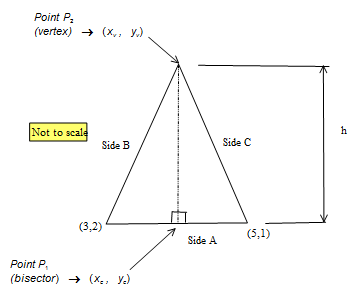An isosceles triangle has sides A, B, and C with sides B and C being equal in length. If side A goes from #(5 ,1 )# to #(3 ,2 )# and the triangle's area is #16 #, what are the possible coordinates of the triangle's third corner?
1 Answer
I have taken you nearly to the end. It just a matter of algebraic manipulation.
Explanation:
In geometry it always a good idea to draw a quick sketch. It helps clarify what you need to do and also shows the person marking your work that you have given thought about the solution.

Given:
Length of side B is equal to length of side C
Coordinates of vertex AB
Coordinates of vertex AC
Area of triangle is
'~~~~~~~~~~~~~~~~~~~~~~~~~~~~~~~~~~~~~~~~~~~~~
Step 1. Relate area to length of side A to determine height h
Step 2. Determine point
Step 3. Determine gradient of line for side A
Step 4. Determine equation of line
Step 5. Using h determine
'..................................................
Using Pythagoras determine length side A
'................................................................
Point
'................................................................
gradient (m)
'................................................................
Standard form equation:
In this case the gradient is
Substitution gives
'..............................................................
But from step 4
'.....................................................................

